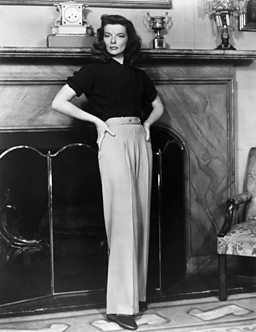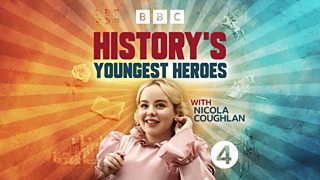Why Katharine Hepburn was one of Hollywood’s most unusual stars
In the ÃÛÑ¿´«Ã½ Radio 4 podcast History’s Heroes, Alex von Tunzelmann looks at extraordinary true stories from across history of people with purpose, brave ideas, and the courage to stand alone.
Katharine Hepburn was one of Hollywood’s most unusual stars. In an era when the studio system was designed to mass-produce female stars along rigid lines of age, appearance, opinions and behaviour, she fought to be completely herself.
Who was Katharine Hepburn?
Hepburn was born in 1907 into a Connecticut family where she and her five siblings were encouraged to hold strong opinions: her father was a doctor and her mother was an activist, campaigning for women’s rights. As a child, she cut her hair short and answered to the name “Jimmy”. She was close to her older brother Tom, who sadly took his own life when she was 13, leaving her devastated.
She's a woman who walked tall and she walked in her own shoes.
Hepburn went on to study at the prestigious women’s college Bryn Mawr, but was drawn to acting. She was spotted by a Hollywood agent while performing a theatrical role on Broadway. Her unconventional masculine style and elite “Mid-Atlantic” accent marked her out from most Hollywood starlets. She demanded an unheard-of $1,500 a week for her first film contract, and got it. RKO’s risk paid off when she won the Academy Award for Best Actress for her third film, Morning Glory.
What was the Hollywood studio system?
From the late 1920s, Hollywood film production was dominated by a handful of major studios, who were able to control every stage of the process from concept to distribution. Actors, writers and directors often signed long-term contracts with these studios. This meant they didn’t necessarily choose their projects film by film, but appeared only in productions offered to them by the studio.
After scandals in the early days of Hollywood, studios began to insert wide-ranging “morality clauses” into contracts, allowing them to fire actors who did anything controversial. Katharine Hepburn clashed with her studio, RKO, over her insistence on wearing trousers: still unusual for women in the early 1930s. Once, on set, aides took her dungarees away. Rather than put on a skirt, Hepburn simply walked around for the rest of the day in her shirt and underwear.

Why was she such an unusual star?
In the 1930s, there was a growing moral panic about movies corrupting American values. Studios introduced the Motion Picture Production Code, known as the Hays Code after the man who oversaw it. This was a strict regime of self-censorship to regulate the moral content of films. It covered everything from sex and violence to sexuality (banning homosexuality and miscegenation – relationships between people of different races), criminal activity (which always had to be punished on screen), and depictions of the clergy (who could not be shown as villains or comic characters). Stars like Katharine Hepburn were expected to uphold morality clauses in their off-screen lives too. This wasn’t her style: by the age of 26 she had already divorced her husband and had an affair with her agent. She was emphatic that she never wanted children. Rumours abounded that she was lesbian or bisexual. She forged a new direction onscreen as one of the great comic actresses of the age in screwball comedies like The Philadelphia Story.
She was... castigated as a communist or a communist sympathiser.
How did Katharine Hepburn come to the attention of the authorities?
Hollywood was a target for McCarthyism, the wide-ranging campaign against communism led in the United States Senate by Joseph McCarthy. In 1947, Hepburn spoke at a rally for former vice president Henry A. Wallace, who was then warming up for a presidential run with the new Progressive Party. She defended free speech and attacked censorship. “She perhaps misjudged the moment or misjudged the strength of her opposition because she was sort of castigated as a communist or a communist sympathiser,” says film historian Pamela Hutchinson. The FBI started a file on Katharine Hepburn. As well as her political activity, they eventually began to track her love affair with her regular co-star, Spencer Tracy. Tracy was married to a woman who wouldn’t divorce him, and he and Hepburn had to keep their relationship out of the press – though it was an open secret in Hollywood.
How did Katharine Hepburn reinvent her career in the 1950s?
Then as now, Hollywood tended to favour young women stars and offered few substantial roles to women in middle age. In her early 40s, Hepburn took a risk on an adaptation of a novel, The African Queen. It was a rare romantic lead for a middle-aged woman. The director John Huston and her co-star Humphrey Bogart, like her, were considered suspect by the McCarthyites. The African Queen was filmed partly on location in Uganda and the Belgian Congo, and production was physically gruelling. Hepburn contracted a nasty bug, which meant some scenes had to be stopped so she could vomit between takes. But the film was a hit, and both she and Bogart were nominated for Academy Awards (she lost that year to Vivien Leigh in A Streetcar Named Desire). Her complete tally of 12 nominations for Best Actress set a record that was only surpassed later by Meryl Streep.
Did she settle into a quiet old age?
Not at all. Hepburn went on to win three more Oscars, all after the age of 60. Though Spencer Tracy remained married to another woman, she lived with him until his death, later describing their relationship as 27 years of “absolute bliss”. She did not attend his funeral so as not to embarrass his family. She continued to campaign for progressive political causes, including Planned Parenthood. She appeared on screen until her late eighties, losing none of the fiery confidence that made her a star. “She's a woman who walked tall and she walked in her own shoes,” says Hutchinson. “And I know that you can summon that energy if you really want to be a little bit more Katharine Hepburn – that means to step forward and be yourself all day.”





